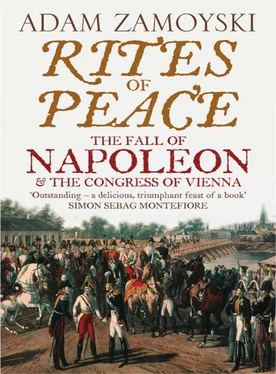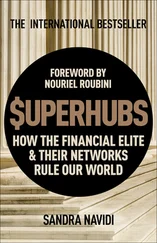
RITES of PEACE
The Fall of Napoleon & the Congress of Vienna
ADAM ZAMOYSKI

Cover Page
Title Page RITES of PEACE The Fall of Napoleon & the Congress of Vienna ADAM ZAMOYSKI
Introduction
1: The Lion at Bay
2: The Saviour of Europe
3: The Peacemakers
4: A War for Peace
5: Intimate Congress
6: Farce in Prague
7: The Play for Germany
8: The First Waltzes
9: A Finger in the Pie
10: Battlefield Diplomacy
11: Paris Triumph
12: Peace
13: The London Round
14: Just Settlements
15: Setting the Stage
16: Points of Order
17: Notes and Balls
18: Kings’ Holiday
19: A Festival of Peace
20: Guerre de Plume
21: Political Carrousel
22: Explosive Diplomacy
23: Dance of War
24: War and Peace
25: The Saxon Deal
26: Unfinished Business
27: The Flight of the Eagle
28: The Hundred Days
29: The Road to Waterloo
30: Wellington’s Victory
31: The Punishment of France
32: Last Rites
33: Discordant Concert
34: The Arrest of Europe
Bibliography
Index
About the Author
Notes
By the Same Author
Praise
Copyright
About the Publisher
The reconstruction of Europe at the Congress of Vienna is probably the most seminal episode in modern history. Not only did the congress redraw the map entirely. It determined which nations were to have a political existence over the next hundred years and which were not. It imposed an ideology on the whole Continent, derived from the interests of four great powers. It attempted to set in stone the agreement between those powers, with the result that their expansionist urges were deflected into Africa and southern Asia. It entirely transformed the conduct of international affairs. Its consequences, direct and indirect, include all that has taken place in Europe since, including aggressive nationalism, Bolshevism, fascism, the two world wars and, ultimately, the creation of the European Union.
The action was played out in a dramatic series of shifts of fortune, by some of the most fascinating characters of European history. At its heart stood Napoleon, fighting desperately for his throne, yet undermining his chances with every move he made and seeming to court disaster with apparent abandon. On the other side, Tsar Alexander of Russia, by now convinced of a divine calling to save the world, could not see that he posed a threat to it in the eyes of everyone else. The consummate political puppeteer Metternich excelled himself as he cajoled and manipulated in order to mould events to his own vision of a safe world. The vulpine Talleyrand weaved about in a desperate attempt to save something for France, and himself, from the wreckage of Napoleon’s empire. The eminently likeable Castlereagh, a thoroughly decent man in every respect, found himself cutting up nations and trading souls as ruthlessly as any practitioner of realpolitik . A host of other characters took their places in this great carnival at one time or another, including the Duke of Wellington, who revealed himself to be as good a statesman as he was a general, and a fascinating array of women, who played on the passions and frustrated ambitions of the great men of Europe, leading to moments of high tragedy and low farce. From gore-spattered battlefield and roadside hovel to the gilded boudoirs and ballrooms of Vienna, the scene of the action is eminently worthy of the grandeur and the squalor of the proceedings. And history has passed down an image of courtly elegance and waltzing frivolity familiar to most educated people.
Yet when I typed the words ‘Congress of Vienna’ into the British Library catalogue, I was rewarded with a list of books on: the First International Meteorological Congress, the Congress on the Biochemical Problems of Lipids, the European Regional Science Association Congress, on congresses statistical, sexual and philatelistic, on the congresses of Applied Chemistry, of Bibliophiles, of Dermatology, of Genealogical and Heraldic Sciences, Varicose Veins, Exfoliative Cytology, Birth Defects, Hepatitis B, Electroencephalography, Clinical Neurophysiology, and many, many more, all held in Vienna over the past century or so. Buried amongst these enticing titles were no more than half a dozen which related to the events of 1814–15.
Further searches revealed that literature on the subject is indeed elusive. It is also extremely one-sided and subjective. The voluminous and dense German studies, mostly produced during the nineteenth-century unification of Germany or during the period of Nazi rule, respond to a demanding agenda. The latest French contribution is entitled ‘ Le Congrès de Vienne. L’Europe Contre la France ’, which sums up a viewpoint characteristic of much French writing on the subject. British studies are marked by an ineffable condescension, based on ignorance of conditions in Europe and a conviction that Britain was a disinterested, and therefore impartial and benign, party. Whatever their provenance, most existing books on the congress are superficial in nature, and the best ones are, ironically, those that honestly set out to cover only the social and sexual side of the proceedings. In short, there is no satisfactory general study of the episode, and as a result most people know little about it, aside from the fact that a great deal of dancing took place.
The reasons for this became clear as I began to grapple with the complexities of the subject. The first is that the Congress of Vienna never actually took place in any formal sense. Just as ‘Yalta’ stands for negotiations and agreements from 1943 to 1945 and even beyond, ‘the Congress of Vienna’ is a blanket term for a process that began in the summer of 1812 and did not end until ten years later. As usual in such a long-drawn-out process, it is the minor details left unresolved in the very early stages of the negotiations that come to dominate and distort the proceedings at the crucial final stages. There is therefore no way of producing a comprehensive and comprehensible account of the episode without covering a very long period, which involves a great deal of work and dictates a more complex book than many a historian would wish to embark on.
Another, equally important, factor is the need for anyone intending to approach this subject to have a command of as many European languages as possible. The negotiations of 1812–15 can be likened to a game of poker, and as in poker, the course of the game only becomes comprehensible if one can see what cards each of the players holds and how he plays them. In addition, and this is an aspect that has probably been most difficult for historians brought up in other times to deal with, it is necessary to be able to empathise with the desires and the fears of every player, otherwise their moves and reactions make no sense. The reason it nearly came to war several times during the Congress of Vienna was not that Prussia was being gratuitously aggressive, Russia perverse, or Austria devious, but that each was in dread of being outmanoeuvred by the others.
In writing this book, I set out to give as full an account as possible of the negotiations that led to the peace settlement, in the hope that the succession of events will add up to some explanation of how it was reached. I have tried to present the hopes and fears of each side as dispassionately, but with as much sympathy, as possible, in the firm conviction that there were no ‘good’ or ‘bad’ players, merely frightened ones.
Читать дальше














